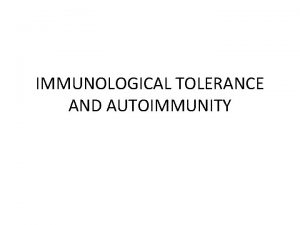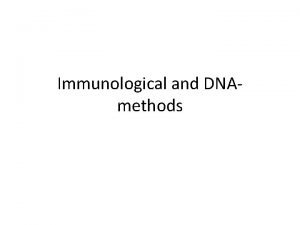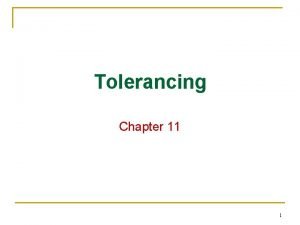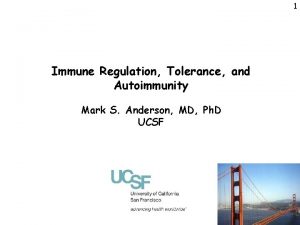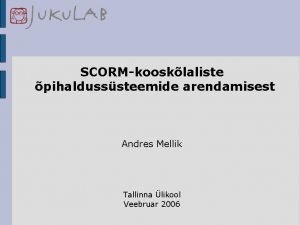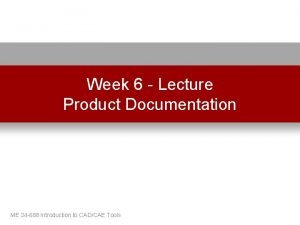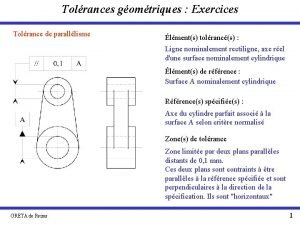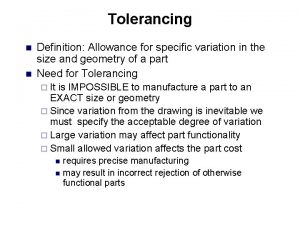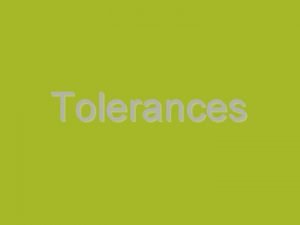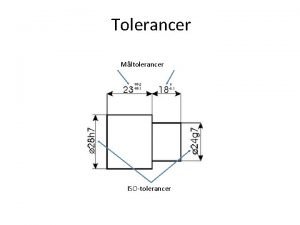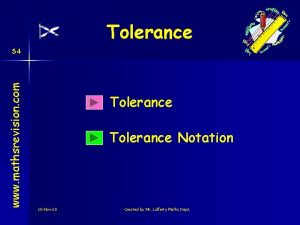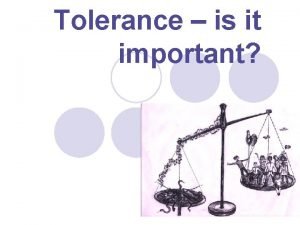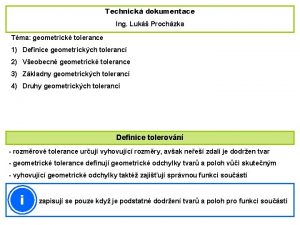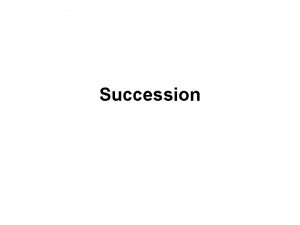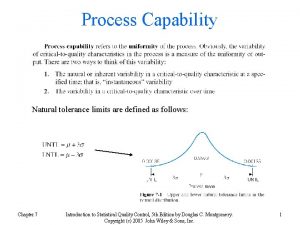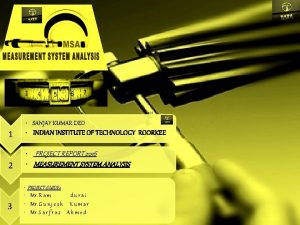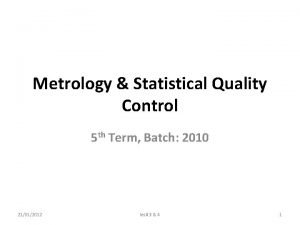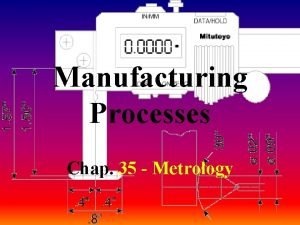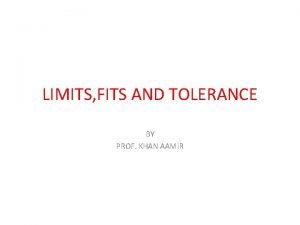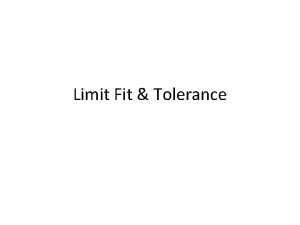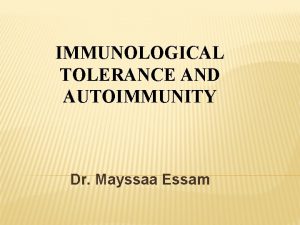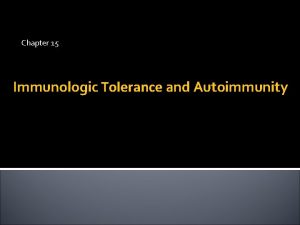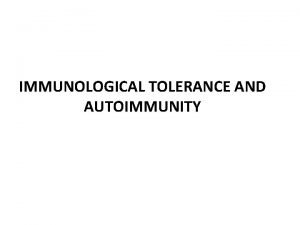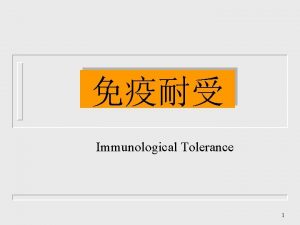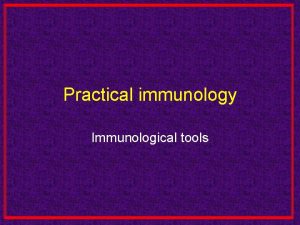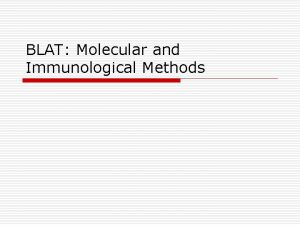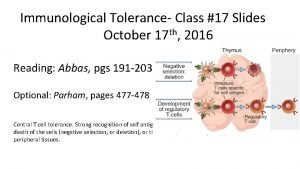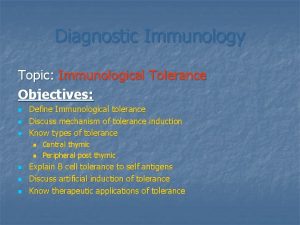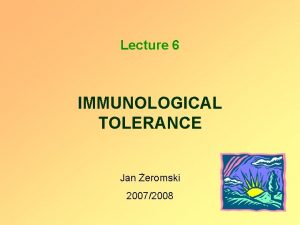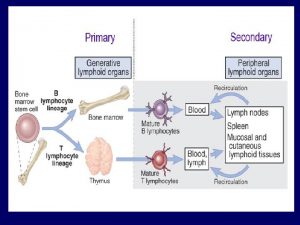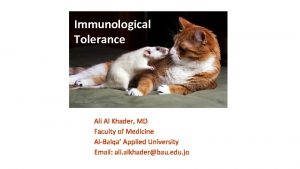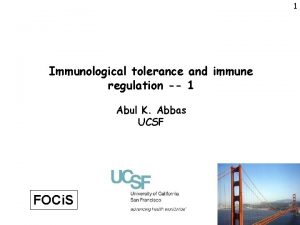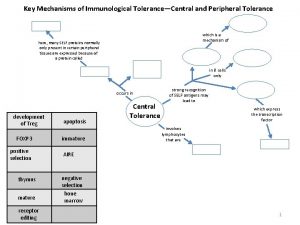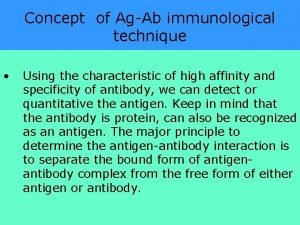Chapter 15 Immunological Tolerance 1 1 Concept Outline





























- Slides: 29

Chapter 15 Immunological Tolerance 1

1. Concept Outline • Immunological Tolerance: These antigen specific T cells and B cells can not be activated to induce immune response under stimulation of Ag. This phenomenon is called immunological tolerance. • Tolerogen: antigens that induce tolerance. activation Ag effect T/B — 2

2. Features: • Only play tolerance to definite Ag, but play good immune response to other Ags (immunologically specific). • Only adaptive immunity has tolerance. • Normal individuals are tolerant of their own antigens(self antigen)----- Self-tolerance. 3

3. Difference among Immunological tolerance , Immunodeficiency &Immunosuppression • Immunosuppression: The suppression of immune responses to antigens. This can be achieved by various means, including physical and chemical factors ----non -specificity to Ag • Immunodeficiency: Any condition in which there is deficiency in the production of humoral and /or cellmediated immunity---non-specificity to Ag. Immune function is disturbed by artificial or non 4 artificial means.

4. Classification of immunological tolerance According to Ag: • Self tolerance – self Ags • Induced tolerance – foreigen objects,need definite conditions According to formation region: • Central tolerance • Peripheral tolerance 5

Section I. The development of immunological tolerance I. Induction of immunologic tolerance to antigen in embryonic period and neonatal period —— maintain lifetime 6

Owen first observed phenomenon of immunologic tolerance in Dizygotic bovine twin in 1945 • Graft of Skin From A to B or From B to A No rejection A B Self –tolerance 7 Antigen is introduced into the body early enough in development, the animal would consider it “self” and not react against it.

Medawar induced successfully immunologic tolerance in neonate period mice in 1953 Strain B mouse Strain A mouse Strain C mouse Neonate mouse Bone marrow 8 weeks later Skin graft Graft survival Graft rejected 8 8

II. Induction of immunologic tolerance to antigen after birth or in adult (I) Antigen-associated factors 1. Dose of antigen Inject different dose of BSA to mouse 10 -8 M No Ab 10 -7 M High level Ab 10 -5 M No Ab Low dose tolerance High dose tolerance Mitchison 1964 9

High-zone tolerance Low-zone tolerance T cell Immune response T, B cell tolerance • low zone tolerance – T cell – antigen low dose,APC cannot form adequate peptide-MHC • high zone tolerance – T cell 、B cell – Induce Ts cell activation or induce apoptosis of responding cell 10

Comparison of T cell tolerance with B cell tolerance ________________________ Contents T cell B cell _____________________________ Tolerance formation easy difficult Antigens TD -Ag TD- Ag and TI –Ag Dose of antigens high or low high Induced time shorter (1 -2 days) longer (more than 10 days) Maintaining time longer (a few months) shorter (a few weeks) __________________________ 11

2. Types of antigen • Large, aggregated, complex molecules • simple small molecules, Soluble, aggregate-free, not processed -tolerance 12

3. Pathway of antigen entering body • Oral Mucosa immunization, tolerance in body • Intravenous • Intra-peritoneal • Intramuscular • subcutaneous Immune response tolerance 13

4. Antigen exist persistently No costimulate signal Activation Apoptosis 5. Features of epitope Some epitope can induce tolerance. Determinants recognized by Ts or Treg induce tolerance. 14

Host–associated factors Age and development stage embryonic period > neonatal period > adult age > old age Newborn (mice), immunological immature. Physiological state Immune suppression Genetic background Hepatitis B vaccine 15

Section II. Mechanism of tolerance I. Mechanism of central tolerance -Central tolerance: occurs in the central immune organs as a consequence of immature self-reactive lymphocytes recognizing ubiquitous self-antigen. ----negative selection. -Peripheral tolerance: Tolerance was induced in peripheral organs as a result of mature self-reactive lymphocytes encountering antigens in vivo or in vitro under particular conditions. 16

I. Central tolerance • T cell central tolerance : formation in thymus Clonal deletion in negative selection • B cell central tolerance: formation in bone marrow Clonal deletion Clonal anergy (clonal inactivation) Receptor editing 17

1. T cell central tolerance T cell Clonal deletion (cell apoptosis) During maturation of T lymphocytes in the thymus, immature T lymphocytes that recognize ubiquitous self-antigen with high affinity are deleted by mechanism of apoptosis. 18

Clonal deletion: negative selection in the thymus Cortex Medulla 19

2. B cell central tolerance Clonal deletion During maturation of B lymphocytes in bone marrow , immature lymphocytes that recognize membrane-bound self-antigen with high affinity are deleted by apoptosis. Clonal anergy (clonal inactivation) During maturation of B lymphocytes in bone marrow , immature lymphocytes that recognize soluble self-antigen are not deleted but are inactivated. Receptor editing If the BCR of some immature B lymphocyte can bind to the selfantigen at high affinity , the light chain gene of BCR on the other allele will start rearrangement to produce a new BCR to replace the old.

Negative selection of B cell in bone marrow (clonal deletion) 21 21

Clonal anergy in B cells 22

II. Mechanisms of Peripheral Tolerance Clonal deletion Immune ignore Clonal anergy The function of immunoregulation cells Immunologically privileged sites 23

1. Clonal deletion: -self Ags at high concentration and affinity can induce self-reactive T cells clonal deletion. 2. Immunological ignorance: -self Ag at low concentration or affinity can induce selfreactive T cells clonal ignorance. When Ag concentration increasing , this tolerance can be stopped. 24

Self-reactive T cell clones No response No clonal deletion No clonal anergy Corresponding tissue specific Ag Immunological ignorance Enough Too low Immunological response T cell reponse Corresponding tissue specific Ags Self-reactive T cell clones

3. Clonal anergy -Self Ag can not activate DC, which can not supply the secondary signal to T cells. 4. The function of regulatory T cells (CD 4 CD 25 T、 + + Tr 1、Th 3) Cell-cell contacting Treg Inhibit T cell response CK(IL-10, TGF-β) 26

5. Immunological privileged sites Under physiological condition, Antigens in immunologically privileged sites can not induce immune response. -Physiologic barrier brain, anterior chamber of eye(crystalline lens), didymus , placenta -promote Th 2 inhibit Th 1 -Fas. L induce lymphocytes with Fas apotosis -Immunosupressive cytokines TGF- 、IL-4、IL-10 28

Section III. Immunologic Tolerance and Clinic Medicine 1. To induce immunologic tolerance ü Prevent the rejection of organ allografts and xenografts Treat autoimmune diseases Treat allergic diseases ü ü 2. To terminate immunologic tolerance ü ü To treat tumor: enhance first signal or second signal To treat infection diseases 29

Exercise • Immunological tolerance definition and feature. • Comparison of T cell tolerance with B cell tolerance • Mechanism of central tolerance and periphery tolerance? 30
 Ana hep
Ana hep Immunological methods
Immunological methods Unilateral tolerance and bilateral tolerance
Unilateral tolerance and bilateral tolerance Central tolerance and peripheral tolerance
Central tolerance and peripheral tolerance Sentence outline example
Sentence outline example Andres mellik
Andres mellik Outline concept
Outline concept Compare and contrast the real self and ideal self
Compare and contrast the real self and ideal self Contoh selling concept
Contoh selling concept School zero tolerance policy
School zero tolerance policy Decimal tolerance chart
Decimal tolerance chart Tolérances géométriques
Tolérances géométriques Tolerancing definition
Tolerancing definition What is a unilateral tolerance
What is a unilateral tolerance Geometriske tolerancer
Geometriske tolerancer Tolerance in maths
Tolerance in maths Tolerance notation
Tolerance notation Why is tolerance important
Why is tolerance important Kruhové házení
Kruhové házení Tolerance model of succession
Tolerance model of succession Natural tolerance limits definition
Natural tolerance limits definition Precision tolerance ratio
Precision tolerance ratio Tolerance vs acceptance
Tolerance vs acceptance 25f7 tolerance
25f7 tolerance 25h7 tolerance
25h7 tolerance Reference dimension
Reference dimension Define allowance in metrology
Define allowance in metrology Tableau alesage arbre
Tableau alesage arbre Limit fit tolerance
Limit fit tolerance Maximum and minimum metal condition
Maximum and minimum metal condition
